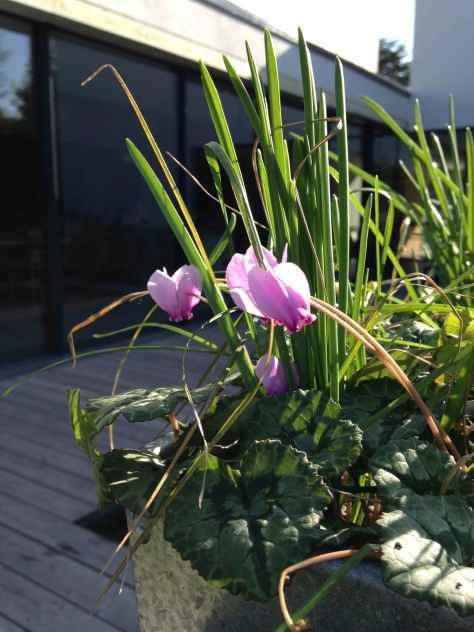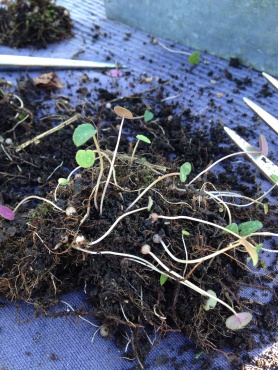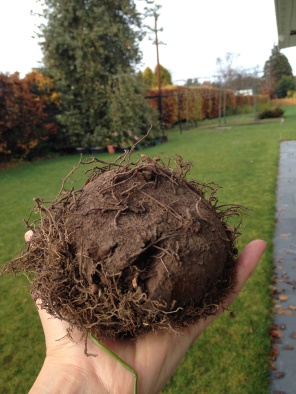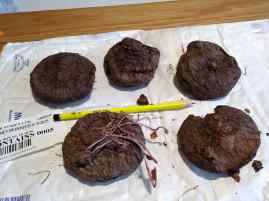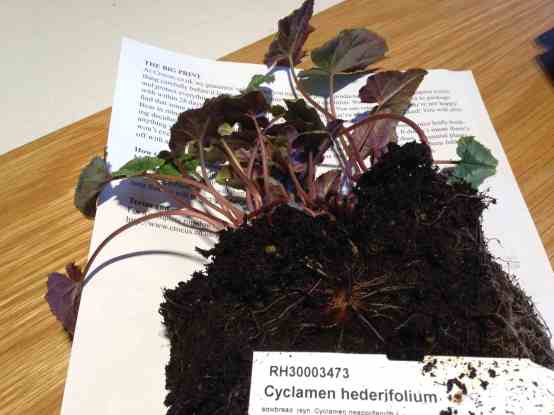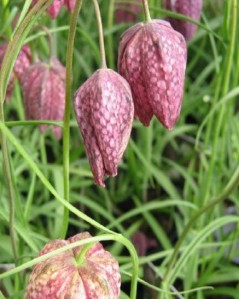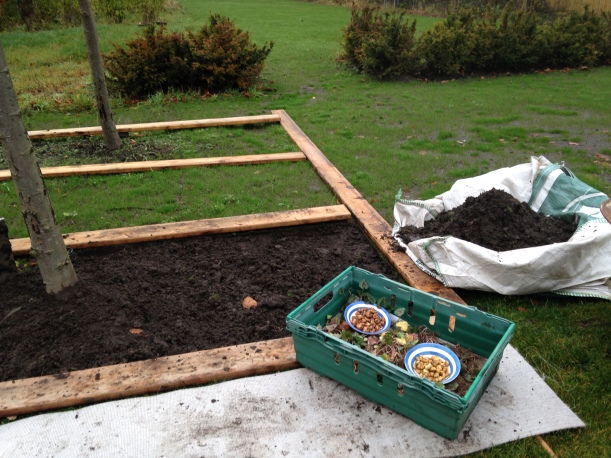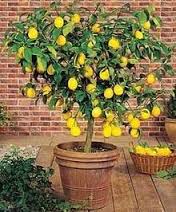Hardy cyclamen are wonderful plants, quite unlike their trashy indoor cousins.
I have a particular weakness for scent, autumn colour and plants with winter interest, and although unscented the ivy-leaved (or Neapolitan) cyclamen excels in the latter two categories, sending up its charming pink recurved flowers in the autumn, and most obligingly holding on to its heart shaped leaves, intricately marked with silver, over the winter months, shedding them over the summer when their absence goes unnoticed in the midst of all the other star horticultural performances.
I really should investigate Cyclamen coum, which flowers from December to March and would take over nicely from the September to November flowering of C. hederifolium, but I have read that if planted together C. coum will in time (which is relative – centuries, probably) come to dominate, so I will have to wait to find a source and a good spot. However their circular leaves are unmarked and nowhere near as interesting.
The greatest downside of C. hederifolium, if one wants a swathe of them (and who would not?), is their cost. Even my first choice of bulb supplier, Peter Nyssen, was charging over £1 per tuber. At this point, I turned my beady and acquisitive eye towards my unsuspecting mother. My mother is not a gardener but she is hugely generous of spirit and has a lovely garden, blessed with great drifts of hellebores and, I remembered covetously, hardy cyclamen.
When we were building the house and lived for almost five years in rented accommodation with a pocket handkerchief of a garden, she made me up a horticultural care parcel containing plants from her garden which I arranged together in a planter and which lifted my frustrated gardening spirits no end. (In the preceding sentence I use the term ‘made me up’ as a euphemism for ‘allowed me to plunder her garden during one of my visits, digging up what I wanted, and leaving it for her to wrap in damp newspaper and post them all up to me in a cardboard box’.) There were a number of cyclamen tubers in this planter, and I had noticed that the flowers had set seed – those seedpods on curious little coiled springs – and that many had germinated into seedlings, a year or so old. I resolved to turn out the planter, carefully, and prick out the seedlings into a tray of jiffy modules – why, I would soon have hundreds of hardy cyclamen. Pricking out seedlings is soothing pastime, providing one sets up the bench or table to avoid being hunched over and getting a crick in the neck or between the shoulder blades, and I spent a restful and virtuous sunny October afternoon doing just that.
Pleased though I was with my labours, I recognised that it would be many years before the pinhead sized tubers produced any flowers, so I turned once more to my mother and asked her, with what I hoped was engaging directness, whether she would dig up some more tubers and send me them (or ‘instruct Tim who comes on Wednesdays to dig up etc’). Again she obliged, and Parcelforce duly delivered two boxes filled with magnificent tubers, some bigger than my hand (see photo below). I have no idea how old they are, and while the literature relates how they can grow to the size of dinner plates, I have found nothing that gives a timescale for this development. Readers, if you can shed some light, I would be delighted to hear from you.
The tubers themselves are odd, unpromising things, with hardly any roots, and it is difficult to imagine them ‘throwing up hundreds of flowers’ per tuber, as the books would have them do. Bought dormant from bulb suppliers, many have no roots at all and it is often difficult to know which way up to plant them. Planting any bulb, I think, is an act of faith, but cyclamen require belief of Orpheus-like proportions.
Out of curiosity, I also ordered some tubers from Peter Nyssen to compare, and a plant from Crocus, and then succumbed to buying some more tubers when I was in Dobbies (despite the recent mis-labeled anemone experience), to see which would give me the best results for my time, effort and money. Contenders in my unofficial and woefully unscientific hardy cyclamen trial are:
1) Five dormant tubers from Peter Nyssen (photo below left) – £6.50
2) Five dormant tubers from Dobbies garden centre (photo below right) – under £10
3) Two boxes of tubers from my mother’s garden, semi-dormant (i.e. freshly dug up and showing some signs of root or leaf growth) – free, but clearly not everyone has access to such cyclamenic munificence
4) 300+ seedlings – free, ditto
5) A plant in a 9cm pot from Crocus (photo below) – £2.99
The plant (by its very definition in a non-dormant state) from Crocus was the real surprise, with that little 2cm tuber throwing up dozens of leaves and all those fine root hairs. If the dormant tubers lumber into life with anything near this fecundity I shall have veritable carpets of cyclamen, I’m just finding it incredibly hard to believe this with any conviction. Having planted them this winter – a bit shriveled and apparently dessicated, with their crowns just below the surface of the soil and hopefully the right way up – I am not sure when I should expect signs of life, especially since winter is normally their non-dormant season. Might I have to wait until September to see the first leaves? I just know I will not be able to resist digging one of them up to check whether root development is actually happening, and I hope this doubter’s impatience will not irretrievably damage the plant*.
I went to check on the tubers from my mother that I planted in the beds under the pleached limes, only to find to my annoyance that their stems have been neatly severed, and a few leaves left on top of the mulch. The culprits are our resident rabbits, and I will position some cloches over the cyclamen while I hone my plans for a multi-pronged attack on the blasted creatures.
I will update this post with progress on the plants over the course of the year. Yes, you have heard me say that before, but remember this is still a very young blog. You may or may not have noticed that I have resorted to copying and pasting comments under my WordPress posts that dear and valued readers have put on my Facebook page. I have been wondering what I could do to attract more comments, suggestions and questions to these posts – I would love to get some dialogue going. Is it because WordPress requires some horrid sign in process? Clearly, if this is the case then you are hardly likely to sign in in order to tell me so. If you prefer, you could tweet me @AndTheGarden? Perhaps this too is merely a matter of time, and comments will emerge in the natural order of things. Or, for that matter, not.
* Should I ever be in the privileged position to name a new species of cyclamen, I shall call it Cyclamen eurydice, and take my chances at being smacked in the face for being such a smart arse.

